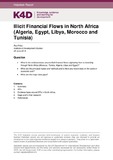| dc.contributor.author | Price, Roz | |
| dc.coverage.spatial | Algeria | en |
| dc.coverage.spatial | Egypt | en |
| dc.coverage.spatial | Libya | en |
| dc.coverage.spatial | Morocco | en |
| dc.coverage.spatial | Tunisia | en |
| dc.date.accessioned | 2020-01-23T11:54:40Z | |
| dc.date.available | 2020-01-23T11:54:40Z | |
| dc.date.issued | 2019-06-25 | |
| dc.identifier.citation | Price, R.A. (2019). Illicit Financial Flows in North Africa (Algeria, Egypt, Libya, Morocco and Tunisia). K4D Helpdesk Report 630. Brighton, UK: Institute of Development Studies. | en |
| dc.identifier.uri | https://opendocs.ids.ac.uk/opendocs/handle/20.500.12413/14985 | |
| dc.description.abstract | This review provides a summary of the evidence on Illicit Financial Flows (IFFs) in North Africa (Algeria, Egypt, Libya, Morocco and Tunisia). Large estimates of the value of IFFs have raised awareness of the issue on the international agenda in recent years. However, there is still no universally agreed-upon definition of IFFs; in particular, an ongoing debate about whether the definition should include international tax avoidance is contentious. Large uncertainties into the magnitude of flows remain, especially given that by their nature IFFs are hidden. In general, the most common working IFFs definitions meet around the core concept of financial transfers across borders that are in some way related to illegal activity (Forstarter 2018b). IFFs are also notoriously difficult to measure. The review first provides some background information on the debates and uncertainties around IFFs, including conceptual issues, difficulties in measuring these flows and their potential impacts. The next section then looks at the evidence base around IFFs in North Africa, including trade-related IFFs estimates, information on money laundering risks and routes, and estimates of stolen assets from previous regimes in North Africa. There are big differences in estimations dependant on methodology, data and assumptions used, although estimations from the same methodology can provide an idea and comparison of the scale of the issue in North African countries. None of these methods (or estimates) is without its detractors and criticisms, and the limitations should be kept in mind when considering the estimates for IFFs. The final section provides some suggestions of further research from the literature. | en |
| dc.language.iso | en | en |
| dc.publisher | IDS | en |
| dc.relation.ispartofseries | K4D Helpdesk Report;630 | |
| dc.rights.uri | https://www.nationalarchives.gov.uk/doc/open-government-licence/version/3/ | en |
| dc.subject | Finance | en |
| dc.subject | Governance | en |
| dc.title | Illicit Financial Flows in North Africa (Algeria, Egypt, Libya, Morocco and Tunisia) | en |
| dc.type | Helpdesk | en |
| dc.rights.holder | © DFID - Crown copyright 2019 | en |
| dcterms.dateAccepted | 2019-06-25 | |
| rioxxterms.funder | Department for International Development, UK Government | en |
| rioxxterms.identifier.project | K4D | en |
| rioxxterms.version | VoR | en |
| rioxxterms.funder.project | 238a9fa4-fe4a-4380-996b-995f33607ba0 | en |

